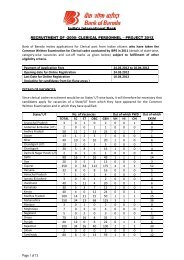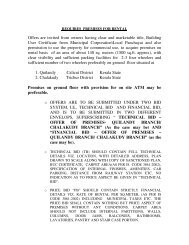Annual Report - Bank of Baroda
Annual Report - Bank of Baroda
Annual Report - Bank of Baroda
Create successful ePaper yourself
Turn your PDF publications into a flip-book with our unique Google optimized e-Paper software.
setting the <strong>Bank</strong>’s aggregate Risk Appetite. In its functions,<br />
it is supported by the Sub Committee <strong>of</strong> the Board for ALM<br />
and Risk Management which, in turn, is supported by the<br />
Credit Policy Committee (CPC), Asset Liability Management<br />
Committee (ALCO), and Operational Risk Management<br />
Committee (ORMC).<br />
The Asset Liability Management Committee (ALCO) meets<br />
periodically to discuss the product pricing for deposits and<br />
advances, maturity pr<strong>of</strong>iles <strong>of</strong> asset and liabilities, the interest<br />
rate view <strong>of</strong> the <strong>Bank</strong>, funding policy, transfer pricing policy<br />
and balance sheet management policy in accordance with the<br />
guidelines issued by the RBI.<br />
The Credit Policy Committee (CPC) has a role to formulate<br />
and implement various credit risk management strategies<br />
including Loan Policy and Off Balance Sheet Exposure Policy<br />
and monitor the <strong>Bank</strong>’s risk management functions on a regular<br />
basis.<br />
The Operational Risk Management Committee (ORMC)<br />
is an executive committee formed with the prime objective <strong>of</strong><br />
mitigation <strong>of</strong> Operational Risk within the institution by creation<br />
and maintenance <strong>of</strong> an explicit operational risk management<br />
process.<br />
Risk Management Policy<br />
Risk Management Policy <strong>of</strong> the <strong>Bank</strong> provides a summary <strong>of</strong><br />
<strong>Bank</strong>’s principles regarding risk taking and risk management.<br />
The principles are based on the best practices and designs<br />
to avoid conflict <strong>of</strong> interests. The <strong>Bank</strong> has developed an<br />
elaborate risk strategy in terms <strong>of</strong> policy guidelines, for<br />
managing and monitoring various risks. In order to provide ready<br />
reference and guidance to various functionaries dealing with<br />
risk management function in the <strong>Bank</strong>, the <strong>Bank</strong> has in place<br />
Asset Liability Management and Group Risk Policy, Domestic<br />
Loan Policy, Mid Office Policy, Off Balance Sheet Exposure<br />
Policy (domestic), Business Continuity Planning Policy, Pillar<br />
III Disclosure Policy, Operational Risk Management Policy<br />
and Internal Capital Adequacy Assessment Process (ICAAP),<br />
Collateral Management and Credit Risk Mitigation and Stress<br />
Test Policy duly approved by the Board.<br />
Risk Management – Implementation and Monitoring<br />
System<br />
In the commercial banking field, the primary risk exposures that<br />
the <strong>Bank</strong> faces are Liquidity Risk, Credit Risk, Market Risk and<br />
Operational Risk.<br />
Liquidity Risk<br />
The main aim <strong>of</strong> the <strong>Bank</strong>’s liquidity management is to<br />
maintain sufficient liquidity (along with an adequate access to<br />
liquid funds at reasonable cost) to meet all its obligations and<br />
commitments as they fall due and also to carry out its normal<br />
banking operations. The overall responsibility for measuring<br />
and monitoring liquidity risk for the <strong>Bank</strong> rests with the Asset<br />
Liability Management Committee (ALCO). The <strong>Bank</strong> manages<br />
17<br />
Jeeef




